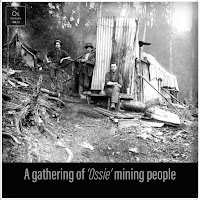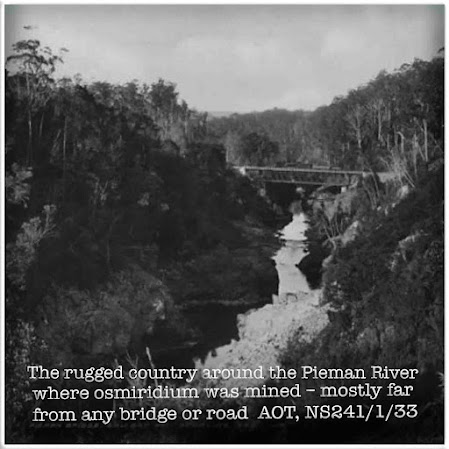Two extraordinarily rare elements in the platinum group of metals are osmium and iridium.
In Tasmania we find them together as a pure silvery alloy we call osmiridium.
It averages about 50/50 osmium and iridium, varying from site to site.
In the 19th century, osmiridium had no value.
From 1881 it was found with gold from Salisbury (Beaconsfield) all the way down to Renison, and regarded as an annoying impurity.
Its density was similar to gold's, making it difficult to separate by sluicing and panning.
It was particularly abundant and annoying to miners east of Corinna, and they were the ones who had it identified, finding out it was worse than worthless.
The mint charged them to remove it from their gold.
By the end of the century, industry was realising how useful its constituent elements could be - from fountain pen nibs to light bulb filaments to munitions, often alloyed with platinum.
The price skyrocketed and by 1920 an ounce of osmiridium was worth nearly ten times as much as gold.
And for years prospectors had been throwing it away!
A rush began prior to WWI, to localities around Waratah and Savage River such as Luina, Heazlewood and Nineteen Mile Creek.
The mineral was found as alluvial deposits in the creeks and rivers, where it looked like steel filings in the pan.
In 1913 a gold miner from Golconda named William Caudry found an original source of the mineral in serpentine rock at Bald Hill, west of Waratah.
This was the first time in the world that a source had been found, and he was granted a reward claim of 40 acres.
Miners followed the finds south along a broad belt of this serpentine rock.
They lost it for a while, until picking it up again in the Renison/Dundas region.
Soon Tasmania was the largest producer in the world.
As these first discoveries petered out at the end of the war, the price was taking off.
In late 1924 a new field was discovered in the Adams River valley, on the eastern side of today's Lake Gordon.
A second rush began and the town of Adamsfield was born.
Well over a thousand miners' rights were issued in 1925, and in spring of that year more than 800 men were prospecting on the field.
Enthusiasm was severely dented when large scale production arose from Russia, leading to a price crash in 1926-7.
Even when prices recovered, the number of miners and local production didn't get back to the previous peaks.
Then came the Depression.
Declining production from the ageing field coincided with falling prices and rising output from South Africa.
A jump in the price during WWII made little difference and Tasmanian production dwindled away to nothing in the 1960s.
You can still find it out west though, and the price has recovered to be about twice that of gold.
END
Osmiridium is a popular name for a naturally occurring alloy of the metals iridium and osmium. Corrosion-resistant, it is used in the manufacture of a variety of articles from pen nibs to munitions. First recognised in the 1880s as an undesirable impurity associated with alluvial gold in western Tasmania, it was discarded by the miners. A penalty was imposed by the Mint for its removal from gold.In 1909 a dramatic increase in price created a boom for the metal, with a rush of miners moving into a number of western mining fields. The collapse of the Russian industry as a result of war and revolution saw prices continue to rise. By 1920 the price reached £38 per ounce and that year the Pieman fields produced 2009 ounces with a value of £77,104. Tasmania had now become the world's largest producer. A second osmiridium rush followed in 1925 with the commencement of alluvial mining at Adamsfield in the state's south-west. In that year £105,570 was paid to miners, but by 1930 the boom had passed with only £16,235 paid to all the miners in the state.The excitement and adventure of the Tasmanian osmiridium-mining boom was the subject of a novel, Jewelled Nights, by Marie Bjelke Petersen, published in 1923. In 1925 a film based on the book starring Louise Lovely was made, largely in the Pieman district. Production of osmiridium continued until 1954, by which time more than 881 kg had been mined.Further reading: A Alexander, A mortal flame, Hobart, 1994; C Burrett & E Martin (eds), Geology and mineral resources of Tasmania, [Brisbane], 1989; A McIntosh Reid, Osmiridium in Tasmania, [Hobart], 1921; C Bacon, 'Notes on the history of mining and exploration at Adamsfield', Mineral Resources Tasmania Report 1992/30, 1992. Chris Tassell |
RANDOM RESEARCH REFERENCES JOHN H ROBINSON LINK ......... https://forum.pmat.org.au/t/finding-osmiridium/265 ......... https://www.appleisleprospector.com/osmiridium-in-tasmania/ ......... https://educalingo.com/en/dic-en/osmiridium ......... https://www.prnewswire.com/news-releases/osmiridium-coin-develops-new-extreme-density-un-counterfeitable-platinum-group-metal-coins-300454943.html ......... https://www.jstor.org/stable/24964944 ......... https://www.facebook.com/tasmanianpioneers/posts/3565039016841620/? paipv=0&eav=AfZWoaJfXghn167Bz1KsY2rnL3CYJ3jfuekFlfjAOvDmTYLgKruqzJgyknExHw5xYbU&_rdr .............. https://collection.maas.museum/object/218132 .......... https://nichaygarth.com/index.php/2017/06/16/on-the-trail-of-hooky-jack-portuguese-ossie-digger/?fbclid=IwAR2dnQxQe-YfzdwX7SNDYY0W6KWzP_qSMK5Hmh8qAlE3YyGeD2rvXTyPfPc
https://forum.pmat.org.au/t/finding-osmiridium/265 .............. https://www.appleisleprospector.com/osmiridium-in-tasmania/ .............. https://educalingo.com/en/dic-en/osmiridium .............. https://www.prnewswire.com/news-releases/osmiridium-coin-develops-new-extreme-density-un-counterfeitable-platinum-group-metal-coins-300454943.html .............. https://www.jstor.org/stable/24964944 .............. https://www.facebook.com/tasmanianpioneers/posts/3565039016841620/?paipv=0&eav=AfZWoaJfXghn167Bz1KsY2rnL3CYJ3jfuekFlfjAOvDmTYLgKruqzJgyknExHw5xYbU&_rdr .............. https://collection.maas.museum/object/218132 .............. https://nichaygarth.com/index.php/2017/06/16/on-the-trail-of-hooky-jack-portuguese-ossie-digger/?fbclid=IwAR2dnQxQe-YfzdwX7SNDYY0W6KWzP_qSMK5Hmh8qAlE3YyGeD2rvXTyPfPc

























No comments:
Post a Comment